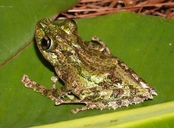|
Description
A highly specialized, medium-sized treefrog, 40-50 mm. Greenish brown colouration resembles the bark of trees. Often a 'W'-shaped marking between the eyes. Hind legs with transverse bands. Ventral surface whitish.
Skin more or less granular with long soft Uroplatus-like dermal fringes, especially along the lateral body parts. Nostrils prominent, nearer to tip of snout than to eye. Tympanum distinct, about 1/3 of eye diameter. Tibiotarsal articulation reaches between eye and nostril. Lateral metatarsalia separated. Webbing 1(1), 2i/e(1), 3i(1-2), 3e(1), 4i/e(2), 5(1). Fingers with well developed terminal disks. Males with a largely distensible, subgular vocal sac and oblong femoral glands, absent in females.
Similar species: Mainly S. fimbriatus, and possibly also S. phantasticus and S. massorum, which all are smaller.
Distribution and Habitat
Country distribution from AmphibiaWeb's database: Madagascar
Ampamakiesiny Pass, An’Ala, Analamazoatra, Andasibe, Ankeniheny, Fierenana, Ilampy, Mananara, Manangotry, Manantantely, Masoala, Midongy, Nosy Boraha, Ranomafana (Ranomena, Ambatolahy forest, Ambatovory, Maharira forest, Vohiparara), Vohidrazana. It occurs from sea level to 1,500m asl in slow-flowing streams and swamps and occasionally fast-flowing streams of rainforest. It is not found in secondary habitats (Nussbaum and Vallan 2008).
Life History, Abundance, Activity, and Special Behaviors
Habits: Common in mid- and low-altitude rainforests but difficult to find. The calls, emitted from high in the canopy, typically 1.5-3 m above the ground, along streams, are very typical and can be recognized even from a loud chorus of other frogs. Clutches of 30-38 eggs are deposited on leaves (often Pandanus leaves) above the streams, the hatching tadpoles complete their metamorphosis in the streams. During the day, the species rests on tree trunks where its silhouette fades due to the cryptic colour and dermal fringes.
Calls: A very loud and intense series of up to nine short "metallic" notes, reminding a hammering blacksmith. A second note type is a short and pulsed croak.
Trends and Threats
It occurs in many protected areas (Nussbaum and Vallan 2008). Possible reasons for amphibian decline General habitat alteration and loss
Habitat modification from deforestation, or logging related activities
Intensified agriculture or grazing
Urbanization
Habitat fragmentation
Comments
Taken with permission from Glaw and Vences (2007).
References
Glaw, F., and Vences, M. (2007). Field Guide to the Amphibians and Reptiles of Madagascar. Third Edition. Vences and Glaw Verlag, Köln.
Nussbaum, R. and Vallan, D. (2008). Spinomantis aglavei. In: IUCN 2008. 2008 IUCN Red List of Threatened Species. . Downloaded on 29 April 2009.
Originally submitted by: Miguel Vences and Frank Glaw (first posted 2000-11-21)
Edited by: Henry Zhu (2009-05-06)Species Account Citation: AmphibiaWeb 2009 Spinomantis aglavei <https://amphibiaweb.org/species/4573> University of California, Berkeley, CA, USA. Accessed May 19, 2025.
Feedback or comments about this page.
Citation: AmphibiaWeb. 2025. <https://amphibiaweb.org> University of California, Berkeley, CA, USA. Accessed 19 May 2025.
AmphibiaWeb's policy on data use.
|
